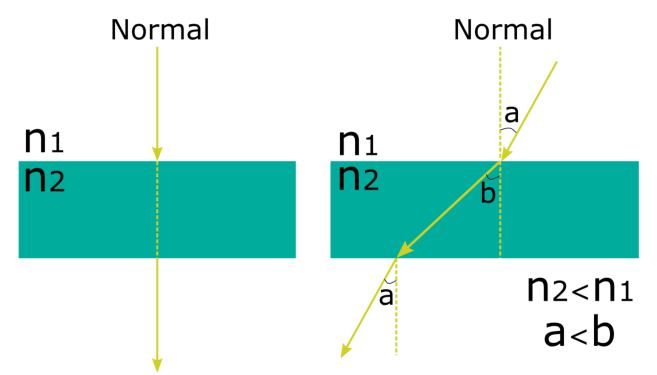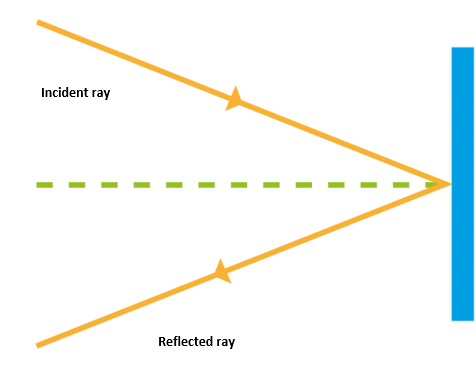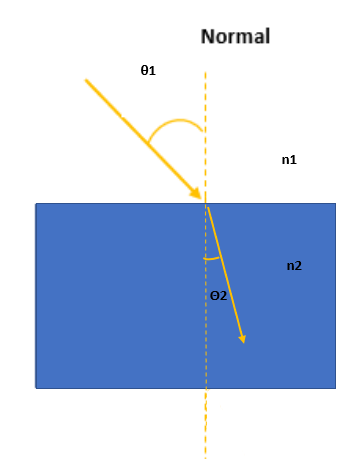The refraction of light rays at a plane surface
Refraction is the change in the direction of an electromagnetic wave when it passes from one medium to another. When the wave moves into a different medium, the magnitude of its speed also changes and causes the wave to change direction.
At the boundary between two mediums, the rays of light change direction at an angle from the normal (which is the normal direction perpendicular to the surface). This diffraction angle depends on the densities of the two mediums through which the light rays pass.
- If the light passes from a low optical density medium to a high optical density medium, the light bends towards the normal line.
- If the light passes from a high optical density medium to a low optical density medium, the light bends away from the normal line.
- When light passes perpendicular to the boundary, the light does not bend.
The above scenarios are illustrated in figure 1. On the left-hand side, you can see that when light passes through the normal, it does not bend. On the right-hand side, you can see that when light passes at any other angle from a high optical density material to a low optical density material, the light bends away from the normal and vice versa.

Figure 1. Refraction of light.
The speed of light depends on the medium the light passes through. When light passes from a low-density medium to a high-density medium, the rays will slow down. This is because there will be more molecules in a high-density medium and therefore more obstacles that slow down the light. As a result, the light will bend towards the normal and away from the boundary.
- Waves travel faster in deeper water. When approaching land, the wave will be displaced in a direction that is perpendicular to the shoreline.
- The rainbow is a phenomenon of the refraction of light when it passes through raindrops, which cause different wavelengths of light to bend. The bending intensity of each of the colours depends on their wavelengths.
Speed and wavelength change during refraction, but the frequency of the wave remains constant.
The reflection of light rays at a plane surface
Reflection of light is the change in the direction of light when the light wave comes in contact with a surface that does not fully absorb the wave’s energy. This results in the reflection of light, which you can see in figure 2.

Figure 2. The reflection of light. Georgia Panagi – StudySmarter Originals
What is the refractive index?
The refractive index, denoted by n, is a property of a material that measures the amount by which light slows down when it passes through it. We can calculate the refractive index with the following equation:
\[n = \frac{c}{c_s}\]
Here, c is the speed of light in a vacuum, and cs is the speed of light in a material (they are both measured in m/s).
Light travels through a vacuum at a constant speed. However, it slows down when it passes through other substances. A high refractive index value means that the material is optically dense, so light travels through that substance slower.
The refractive index should always be greater than 1 as the speed of light in any substance cannot exceed its speed in a vacuum. The refractive index of air can be assumed to be 1 if it is not given.
The law of refraction at a plane surface
Snell’s law states that the angle of the refracted ray of light and the incident ray compose the normal of the boundary at the point of refraction.
Since the refraction angle depends on the medium through which the light passes, there is a relation between the angle of incidence, angle of refraction, and the refractive index. This relation is described by Snell’s law below, where n1 and n2 are the refractive indices of the two mediums, θ1 is the angle of incidence, and θ2 is the angle of refraction.
\[n_1 \cdot \sin \theta_1 = n_2 \cdot \sin \theta_2\]
The incident and refraction angles are shown below in figure 3.

Figure 3. Refraction and Snell’s law.
A ray of light is directed at an angle of incidence of 45° and passes through glass, exiting at an angle of refraction of 32°. Find the refractive index of glass.
Solution
Assume that the refractive index of air is 1. Using Snell’s law and substituting the given values, we get:
\(n_1 \cdot \sin \theta_1 = n_2 \cdot \sin \theta_2 = n_1 \cdot \frac{\sin\theta_1}{\sin \theta_2} = 1\cdot \frac{\sin(45)}{\sin(32)} = 1.334 \)
What is total internal reflection?
When the angle of incidence increases, the angle of refraction increases. When the refraction angle reaches 90°, the light is reflected along the boundary. This angle of incidence that causes total internal reflection is known as critical angle θc, and we can calculate it using the equation below, derived from Snell’s law.
\[\sin \theta_c = \frac{n_2}{n_1}\]
For total internal reflection to occur, two conditions must be met:
- The angle of incidence must be greater than the critical angle.
- The refractive index n1 must be greater than the refractive index n2.

Figure 4. The total internal reflection of light.
A light beam passes from water to air. What is the critical angle between air and water if their refractive indices are 1.55 and 1, respectively?
Solution
We know that the refraction angle must be 90 degrees to have a total internal reflection. Using Snell’s law, we get:
\(n_1 \cdot \sin \theta_1 = n_2 \cdot \sin \theta_2 \rightarrow 1.55 \cdot \sin \theta_c = 1 \cdot \sin(90) \rightarrow \sin \theta_c = \frac{1}{1.55} = 0.65 \Rightarrow \theta = 40.2^\circ\)An example of refraction is a mirror. When a ray of light penetrates the glass, it gets refracted. It then reaches the other end of the mirror and gets reflected. The reflected ray gets refracted again on the outer surface and moves away from the mirror.
Refraction at a Plane Surface - Key takeaways
- Refraction is the change of direction of light when it passes from one medium to another due to its change in speed.
- Light is reflected or scattered in a different direction when it interacts with a surface.
- The diffraction angle depends on the densities of the two mediums through which the light rays pass.
- Total internal reflection occurs when the incident angle is greater than the critical angle, and the refractive index of the incident medium is greater than the refractive index of the second medium.











